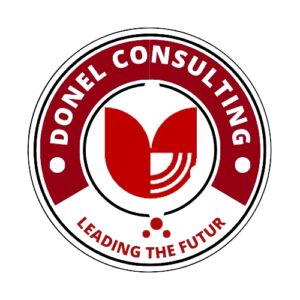Environmental and Sustainability
Here’s how we welp
Environmental Impact Assessments (EIA)
Donel Consulting helps clients conduct comprehensive Environmental Impact Assessments (EIA) to identify potential environmental impacts of projects and develop strategies to mitigate them. Our team of experts ensures that EIAs are tailored to the specific needs of your project and comply with local regulations.
Environmental Audits
We conduct thorough environmental audits to assess the environmental performance of your organization, identifying areas for improvement and providing recommendations for sustainable practices. Our audits are designed to ensure compliance with environmental regulations and enhance your organization’s environmental reputation.
Environmental and Social Management Systems (ESMS)
We help clients establish and implement effective Environmental and Social Management Systems (ESMS) that ensure compliance with environmental and social regulations. Our ESMS solutions are designed to minimize environmental impacts, promote social responsibility, and enhance stakeholder engagement.
Circular Economy Solutions
Donel Consulting offers innovative circular economy solutions that promote sustainable consumption and production patterns. Our team of experts helps clients develop strategies to reduce waste, increase recycling, and promote the reuse of resources.
Policy and Regulation Development
Donel Consulting helps governments and organizations develop and implement policies and regulations that promote environmental sustainability and social responsibility. Our team of experts ensures that policies are evidence-based, effective, and compliant with international standards.
Green Business Leadership Training
We provide comprehensive green business leadership training programs that equip leaders with the skills and knowledge necessary to drive sustainable growth and environmental responsibility. Our training programs are designed to enhance leadership skills, promote sustainable practices, and foster a culture of environmental stewardship.
Get insights from our previous missions
77% of cultivated land is used for meat production.
Despite taking up nearly 80% of agricultural land, industrial animal agriculture produces less than 20% of the world’s supply of calories. In fact, 83% of the world’s calories and 63% of protein actually comes directly from plant-based foods
This disproportionate use of land for livestock has major environmental impacts. Clearing land for pasture and to grow animal feed is a leading cause of deforestation, habitat destruction and biodiversity loss. Around 36% of global crop calories are used for animal feed, compared to 55% that directly feed people.
A look at the Geopolitical Implications of a Tightening Oil Market.
Geopolitical tensions and the tightening of global oil markets are intricately intertwined, with far-reaching implications for economies and international relations. The current landscape, characterized by OPEC+ production cuts, resilient non-OPEC supply, and the looming specter of escalating conflicts in the Middle East, is set to shape the trajectory of oil prices and geopolitical dynamics in the coming years.
Action Orientation: Connect environmental education to real-world action.
The most effective environmental education is action-oriented, allowing students to apply their knowledge to authentic problem-solving. Through project-based learning, community partnerships, student leadership opportunities, and creative integration across subject areas, students gain the skills and sense of agency needed to tackle sustainability challenges now and in the future. Real-world learning experiences are key to inspiring the next generation of environmental changemakers.
Such localized funding structures would serve as catalysts for grassroots renewable energy projects, enabling communities to harness their unique geographical and resource advantages, whether through solar installations in sun-drenched regions, wind farms in areas with consistent air currents, or small-scale hydroelectric systems in water-rich locales.
We should create special funds for renewable energies in each village, commune, and territory.
Building a Circular Economy: Closing the Loop on Electronic Waste Through Product Take-Back Programs
Product take-back programs are structured systems implemented by manufacturers or retailers to collect used or end-of-life products for recycling, reuse, or proper disposal. These programs aim to divert e-waste from landfills, conserve valuable resources, and promote sustainable practices within the electronics industry. By taking responsibility for the end-of-life management of their products, manufacturers can actively contribute to the development of a circular economy, where resources are kept in use for as long as possible, and waste is minimized.
Building a Healthy Africa : A Green Pathway to Economic Growth.
How environmental consciousness can be the engine for Africa’s prosperity.
Investment in Renewable Energy : Africa’s abundant solar, wind, hydro, biomass, and geothermal resources provide significant potential for renewable energy solutions. These resources could contribute to a 6.4% increase in GDP from 2021 to 2050. Legislation plays a crucial role in boosting renewable energy investments by creating conducive environments for such initiatives.
The Emergence of New System Dynamics.
The emergence of new system dynamics is reshaping our world in profound and interconnected ways. As technological advancements and social changes accelerate, we are witnessing the convergence of multiple forces that are creating novel patterns of interaction between our environment, society, and technology.
Economic growth does not necessarily lead to progress as it does not address redistribution.
Donel Consulting on Inclusive Prosperity.
Redistribution policies, such as progressive taxation and social welfare programs, are designed to mitigate this inequality by reallocating resources from wealthier to poorer segments of society.
Achieving a rapid reduction in our footprint without sacrificing human well-being?
Implementing well-regulated carbon markets and emissions trading schemes can effectively reduce carbon footprints. Revenues generated from these mechanisms should be reinvested into policies targeting sectors and populations that bear the costs of such policies.
Humanity’s capacity to increase biocapacity has limits.
Humanity is currently using resources at a rate equivalent to 1.7 Earths, meaning we are consuming natural resources faster than they can regenerate. This overshoot results in ecological deficits where ecosystems are degraded faster than they can recover, causing biodiversity loss and other environmental issues.
Beyond Carbon: A Multi-criteria Assessment Framework.
Donel Consulting developed a framework that considers a wider range of environmental, social, and economic factors alongside carbon footprint.
Limited access to agricultural inputs is a significant bottleneck hindering agricultural productivity in sub-Saharan Africa.
Limited access to agricultural inputs like improved seeds, fertilizers, and irrigation is a major constraint to agricultural productivity growth in sub-Saharan Africa (SSA). Despite the region’s vast agricultural potential, smallholder farmers who produce the majority of the food face numerous challenges that limit their ability to increase yields and incomes.
Scientists have identified nine planetary boundaries, which are environmental thresholds that humanity should not transgress.
These boundaries represent the limits human activity can push Earth’s natural systems before causing potentially irreversible damage.
Now to developing models that analyze the interconnectedness of environmental systems and identifying synergistic solutions that address multiple challenges simultaneously.
The Fiscal Recipe for a Green Economy.
Fiscal policy is a powerful tool for driving the transition to a green economy. By aligning taxes, subsidies, and public spending with environmental objectives, governments can accelerate the shift to sustainable production and consumption patterns.
The Importance of agroecology and local currencies for resilience.
Agroecology and local currencies are two innovative approaches that can significantly enhance the resilience of communities in the face of economic, social, and environmental challenges.
Technological advancements needed for a smooth transition.
In the face of the pressing need to move away from fossil fuels, this study delves into the critical role that research and development (R&D) can play in accelerating the transition to clean energy. The shift away from oil and other carbon-intensive energy sources requires not only policy changes, but also scientific breakthroughs that can transform our energy systems.
Innovation for a Sustainable Future : The R&D Imperative
The transition away from oil presents a unique opportunity to drive scientific progress and develop clean energy technologies that can power a sustainable future. This study focuses on identifying the key areas of innovation that are essential for creating the clean energy technologies and infrastructure needed to support a smooth and equitable transition.
Analyzing the current state of clean energy R&D and pinpointing the most promising avenues for breakthrough innovations, this study aims to provide a roadmap for accelerating the development of clean energy solutions. From advancements in renewable energy generation and storage to the development of carbon capture and utilization technologies, the study explores the diverse range of R&D efforts that can contribute to a just and sustainable energy transition.
Powering Progress: R&D as the Engine of a Just Transition
A just and equitable transition away from oil hinges on the ability to harness the power of scientific research and technological innovation. This study examines the critical areas of R&D that can fuel progress towards a future powered by clean and sustainable energy sources.
Wildlife decline disrupts food webs and ecosystem services.
Integrating renewable energy sources with battery storage and intelligent control systems provides reliable power for rural communities and agricultural operations.
The power of collective action
How individual actions, when aggregated, can create a powerful force for systemic change.
Individual actions, when aggregated, can indeed create a powerful force for systemic change. Grassroots movements and social change often start with the seemingly small actions of committed individuals who inspire others to join their cause. Over time, as more people adopt new behaviors and advocate for change, these individual efforts coalesce into a potent collective force capable of transforming norms, institutions and systems.
While rising populations aren’t the sole factor behind resource depletion, they undeniably contribute to the challenge. With more people, demand for necessities like food, water, and energy naturally increases, placing a greater burden on our planet’s finite resources.
The use of community currencies in Kenya shows how norm-changing individual actions can drive systemic transformation from the bottom-up. By choosing to trade with alternative currencies like Eco-Pesa, community members are asserting their own power to promote local development and resilience
Revitalization and Equity: Ensuring Inclusive Development of Underutilized Urban Land.
Revitalization efforts can have an uneven impact, so this study explores how to achieve inclusive development. We examine strategies like affordable housing, community involvement, and neighborhood character preservation to ensure revitalization benefits all residents.
The Congo Basin faces a complex challenge: balancing conservation with development for local communities. This study explores how livelihood initiatives, which empower communities and respect traditional knowledge, can potentially bridge this gap and achieve both cultural preservation and ecological sustainability.
Carbon Capture and Storage (CCS): From Pilot Projects to Scalable Solutions for Industrial Emissions Reduction
But the primary obstacle to scaling CCS is the high cost and lack of financial incentives. CCS requires significant upfront capital investment in capture, transport and storage infrastructure. The capture process itself is energy-intensive, reducing a power plant’s output by 10-40% while increasing electricity costs by 30-80%
Without a sufficient carbon price or other policies to make CCS cost-competitive with emitting CO2, there is little business case for deployment. Encouraging the massive investment needed – an estimated 120-fold increase to USD150bn annually by 2050 – will require substantial public funding, subsidies, tax credits and other incentives to derisk projects and attract private capital.
Social Acceptance Challenges
Public awareness and acceptance of CCS remain low. Concerns about CO2 leakage, induced seismicity, and confusion with fracking are common. Lack of familiarity with the technology breeds skepticism and local opposition to projects.
Strategies for building farmer capacity in data literacy and decision-making skills.
Practical, Hands-On Workshops : Deliver training through interactive workshops that focus on practical applications of data in real-life farming scenarios. For example, Canada’s Data Literacy Program for Cow-Calf Producers includes exercises using producers’ own grazing, weight, and reproduction data to demonstrate how it can inform better management decisions
The Economic Benefits of Environmental Compliance: Beyond the Regulations

